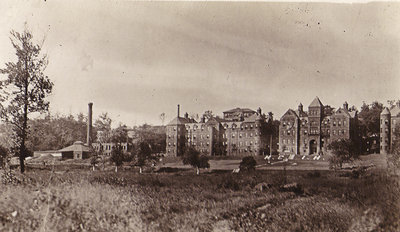They got signed in, but never got signed out.
Like the Hollywood creations “Shutter Island” and “One Flew over the Cuckoo’s Nest,” Secaucus long ago also had a facility to which sane people were sometimes admitted, but were not allowed to leave.
But relax; it wasn’t in the recent past. It was more like 75 to 140 years ago, and it was in a section of town that many still never visit or are even aware of, the Snake Hill section of Laurel Hill County Park.
The Hudson County Lunatic Asylum existed from 1873-1939. Many people signed their relatives in – and most of them didn’t get out.
Back then, the asylum was side by side with other countywide institutions, including a debtor’s prison, a county jail, and tuberculosis and smallpox hospitals.
When it first opened, it had the capacity to house 140 patients. By the time it closed, it held 1,872 people.
It wasn’t very hard to admit a patient at that time, and residents sometimes signed in their elderly relatives when they could no longer afford to care for them.
“Anybody could sign somebody in.” – Dan McDonough
____________
Town historian expert on asylum
The biggest collection of documents about the asylum and the other Snake Hill facilities belongs to Secaucus Town Historian Dan McDonough.
McDonough, who grew up elsewhere but is now Secaucus resident, was fascinated by the Snake/Laurel Hill area after learning about it while an altar boy at a church on the hill in the mid-1950s. Since then, he’s accumulated books, photographs, and records of the asylum and many other institutions on the hill.
“A lot of records aren’t available because people didn’t talk about it,” McDonough said.
The asylums of the 19th century are considered by many to be signs of a questionable period in mental health care. They are often remembered for their inhumane treatment of patients.
The asylum adopted the less offensive “Mental Disease Hospital” moniker in the 1930s.
Easy to sign anybody in
The building that housed the insane of Hudson County had wings separating the male and female patients. There were several beds to a room.
According to McDonough, patients were admitted for a number of disorders, including syphilis and schizophrenia. But another group of people often were signed in who had no reason to be there: healthy residents who had been determined by their relatives to be a burden.
It was not until 2003, when the New Jersey Turnpike Authority was moving the graves of people who had passed on in Snake Hill’s institutions to build Turnpike Exit 15X, that they located their records.
In fact, the cause of death was many times not even recorded, because the patients had been given paupers’ funerals at a potter’s field nearby.
“Anybody could sign somebody in,” McDonough said. However, “you would need three doctors to sign you out.”
Decades of existence
In the 1930s, the Mental Disease Hospital was moved down to County Avenue in Secaucus, at the site where Meadowview Hospital now exists. The Mental Disease Hospital ceased operations when Meadowview began theirs.
Many of the other institutions soon moved off Snake Hill, which had once been basically a completely independent city. The area even had support facilities including a sewer system, reservoir, electricity plant, and incinerator.
By the 1950s, many of the properties were empty, and had fallen into disrepair. Many were damaged by series of fires. In the 1960s, much of the actual “hill” itself was excavated away to ready for sections of the New Jersey Turnpike to be built.
In the 1990s, more than 4,500 bodies of paupers, prisoners, and patients were moved from the area to make way for New Jersey Turnpike Exit 15X, the ramp for the Lautenberg train station (“Secaucus transfer station”) in Secaucus.
Today, of the more than 50 buildings that once existed on Snake Hill, only the foundation of one of the old alms houses remains, nearly out of sight in the brush.
Joseph Passantino may be reached at JoePass@hudsonreporter.com.
